-
Paper Information
- Previous Paper
- Paper Submission
-
Journal Information
- About This Journal
- Editorial Board
- Current Issue
- Archive
- Author Guidelines
- Contact Us
International Journal of Genetic Engineering
p-ISSN: 2167-7239 e-ISSN: 2167-7220
2025; 13(9): 242-250
doi:10.5923/j.ijge.20251309.13
Received: Sep. 6, 2025; Accepted: Sep. 25, 2025; Published: Sep. 29, 2025

Comparison of Respiratory, Cardiovascular, and Hand Grip Strength of Adolescents Living in the Republic of Karakalpakstan by Ecological Regions
K. U. Rozumbetov1, 2, G. K. Shamuratova2, A. T. Esimbetov1
1Department of Veterinary Diagnostics and Food Safety, Nukus Branch of Samarkand State University of Veterinary Medicine, Animal Husbandry and Biotechnology, Uzbekistan
2Department of General Biology and Physiology, Karakalpak State University, Uzbekistan
Correspondence to: K. U. Rozumbetov, Department of Veterinary Diagnostics and Food Safety, Nukus Branch of Samarkand State University of Veterinary Medicine, Animal Husbandry and Biotechnology, Uzbekistan.
| Email: |  |
Copyright © 2025 The Author(s). Published by Scientific & Academic Publishing.
This work is licensed under the Creative Commons Attribution International License (CC BY).
http://creativecommons.org/licenses/by/4.0/

This article analyzes the functional health status of adolescents aged 14-15 living in different ecological regions of Karakalpakstan by assessing hemodynamic parameters (blood pressure and heart rate), respiratory function (vital lung capacity), and hand grip strength. The study revealed that adolescents living in the Turtkul district demonstrated advantages in respiratory and hand grip strength indicators, while in the Muynak region an increase in hemodynamic parameters was observed. Adolescents from Nukus city showed intermediate values for these parameters. Such differences can be explained by ecological factors, air quality, lifestyle, physical activity, and nutritional habits.
Keywords: Ecological condition, Karakalpakstan, Blood pressure, Heart rate, Vital lung capacity, Hand grip strength
Cite this paper: K. U. Rozumbetov, G. K. Shamuratova, A. T. Esimbetov, Comparison of Respiratory, Cardiovascular, and Hand Grip Strength of Adolescents Living in the Republic of Karakalpakstan by Ecological Regions, International Journal of Genetic Engineering, Vol. 13 No. 9, 2025, pp. 242-250. doi: 10.5923/j.ijge.20251309.13.
Article Outline
1. Introduction
- The health of adolescents and young people is an important indicator of the future of society. In particular, the development of the cardiovascular, respiratory, and muscular systems determines the overall health of a child. Adolescence is a period of active development of the cardiovascular system, during which heart rate (HR) and blood pressure (BP) are variable. Since adolescents are in the process of growth and development, studying their hemodynamic parameters helps to assess the normal functioning of the cardiovascular system and to determine such indicators as BP and HR. Changes in hemodynamic parameters may serve as early signs of cardiovascular diseases, BP abnormalities, or other pathologies [1]. In addition, hemodynamic parameters are considered important indicators in evaluating how well the heart and circulatory system function in adolescents engaged in sports and how they respond to physical load.Vital lung capacity (VLC) is considered a key criterion in assessing the respiratory health and overall physical capabilities of adolescents [2]. A decrease in respiratory volume negatively affects not only sports performance, but also social activity and concentration during classes. Children with low VLC are more likely to experience fatigue, reduced attention, sleep disturbances, and even psychological discomfort [3].Hand grip strength (HGS) is also one of the important indicators of the level of physical development. HGS below the norm may be associated with insufficient physical activity, improper nutrition, chronic diseases, or socio-psychological stress [4].The territory of Karakalpakstan is distinguished by its desert and semi-desert nature, climatic conditions, and limited water and food resources. Studying the physiological indicators of adolescents under these conditions helps to develop specific and effective preventive measures in the field of healthcare. The aim of this study is to assess the overall health status of school-aged adolescents living in different ecological regions of Karakalpakstan by analyzing hemodynamic indicators (circulatory and cardiac function), respiratory function (VLC), and HGS parameters, to determine their association with environmental factors, and to develop effective practical recommendations for the field of public health.
2. Materials and Methods
2.1. Participants and Study Area
- For regional zoning, it is noted that changes in the geological characteristics of the area, including air pollution caused by dust and wind erosion indicators, the state of the biocenosis, the diversity and abundance of plant and animal life inhabiting the region, the degree of negative impact from aridization and pesticide contamination, as well as the distance from the ecological disaster center, are taken into account [5-7]. Three ecological zones of the Republic of Karakalpakstan are distinguished from each other [5-7]:1. Participants residing in the northern district of the Republic of Karakalpakstan, specifically in the Muynak district, were included in the “Muynak” group. This area is considered an ecological disaster zone (0-200 km – up to 200 km from the shore of the Aral Sea).2. Representatives living in Nukus city, the central region of the Republic of Karakalpakstan, were included in the “Nukus” group. This area is classified as being under ecological disaster risk and is located approximately 200 km south of the Muynak district.3. The “Turtkul” group consisted of volunteers residing in the southern districts of Karakalpakstan, namely Turtkul and Ellikkala. This region is located about 400 km away from Muynak district and is considered one of the ecologically favorable settlements of the Republic [5-8].
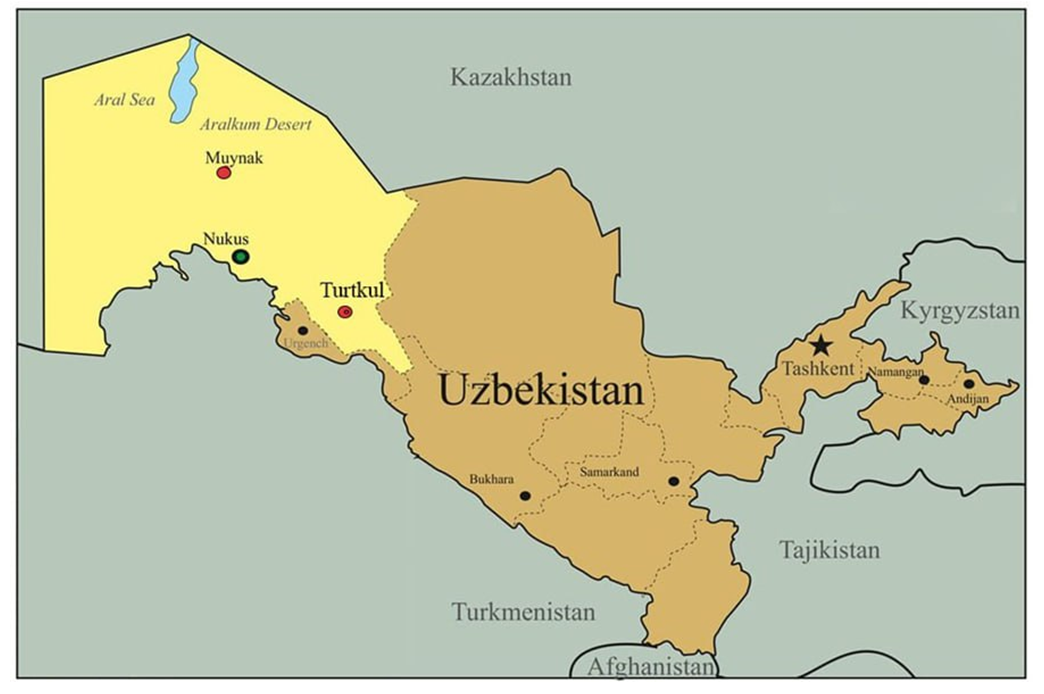 | Figure 1. Schematic map of the location of the territorial groups on which research was carried out |
2.2. Measurement of Physiological Parameters
- Vital lung capacity (VLC): was measured using a spirometer – Electronic Vital Capacity Tester, FCS-10000, Grows Instrument (China, 2018). The spirometry analysis for determining VLC was carried out according to the following procedure:1. The subject stood upright or sat in a correct posture.2. Took a deep breath (maximum inspiration).3. Exhaled as deeply as possible (maximum expiration).4. The volume of exhaled air was recorded by the spirometer.5. Each participant performed the test at least three times, and the most reliable result was documented.In addition, in the volunteers, blood pressure – systolic arterial blood pressure (SBP), diastolic arterial blood pressure (DBP), and heart rate (HR) – was measured on the upper arm using the Korotkov method with an electronic sphygmomanometer OMRON 711 (HEM-8712-CM2) (China, 2017).The level of HGS was assessed using the dynamometric method. HGS was determined with a hand dynamometer MEGEON-34090 (Russia, 2017), with a measurement accuracy of 0.5 kg, allowing for reliable determination of handgrip force. For the test, the participant stood upright with the arm extended laterally and gripped the dynamometer with maximum effort. The test was repeated 2-3 times, and the highest value was recorded in kilograms.
2.3. Statistical Analysis
- The statistical hypotheses about the difference of central tendencies in the three groups were tested for quantitative variables using the Kraskell-Wallis criterion. When statistically significant differences were identified, a posteriori comparisons were performed using the Mann-Whitney criterion with Bonferroni correction to correct for inflation of the 1st kind of error. The results were considered statistically significant at p<0.05. All results were performed using Excel program functions installed in Microsoft Office 2010 application package; using Past (version 2.17, Norway, Oslo, 2012) statistical data processing program. All data are presented as mean (µ) values and lower (LL) and upper limit (UL) of the 95% confidence interval (µ; (LL; UL 95% CI)) of the physiometric parameter.
3. Results and Their Discussion
- The results of the comparison of respiratory function, hemodynamic parameters, and HGS in adolescents living in different ecological regions of the Republic of Karakalpakstan are presented in Tables 1 and 2.
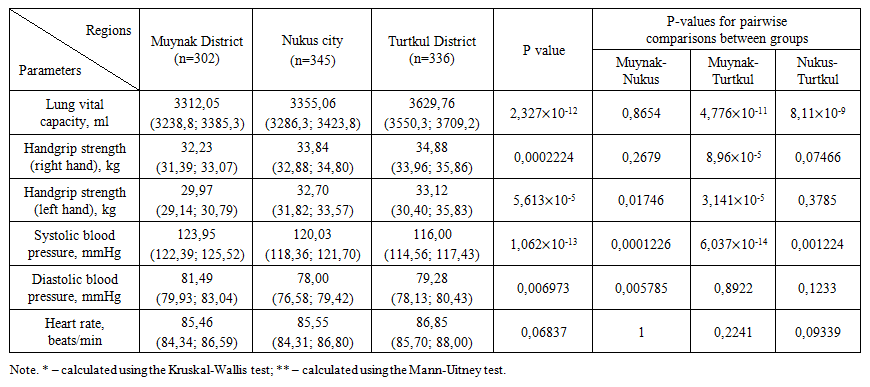 | Table 1. Comparison of respiratory function, hemodynamic parameters, and HGS in adolescent boys from the studied regional groups (μ; 96% CI) (n=983) |
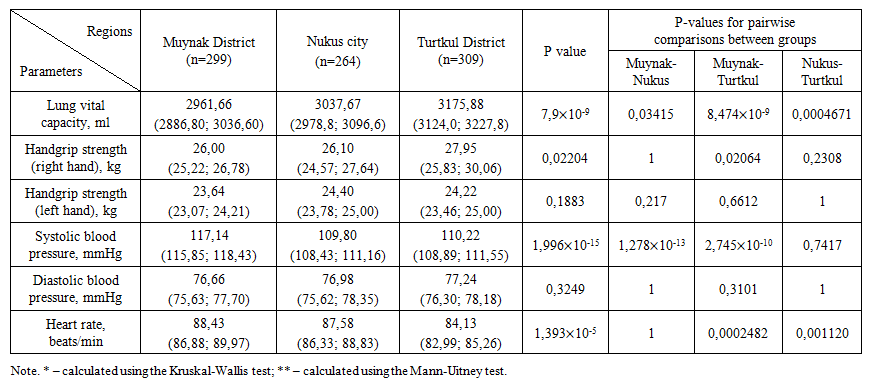 | Table 2. Comparison of respiratory function, hemodynamic indicators, and HGS in adolescent girls living in the studied regional groups (μ; 96% CI) (n=872) |
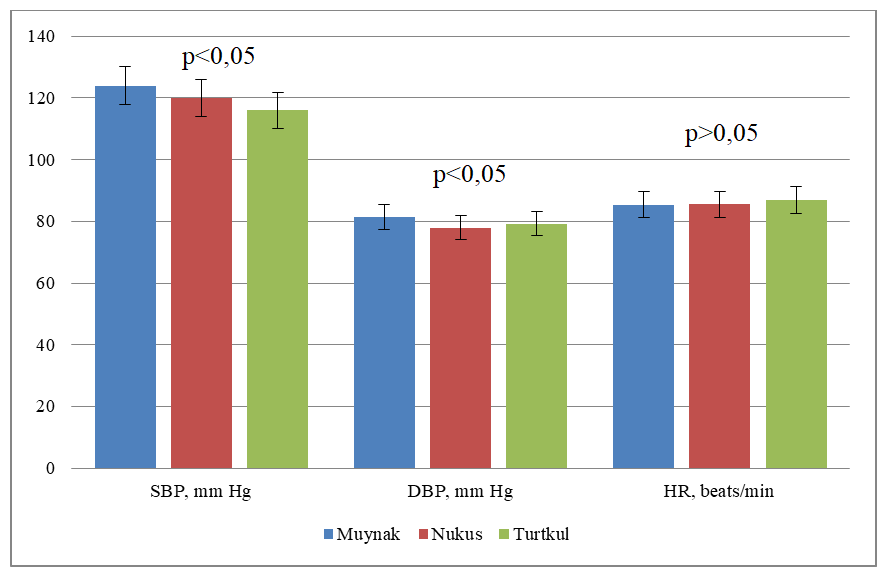 | Figure 2. Comparison of hemodynamic parameters in boys living in the studied regions (n=983) |
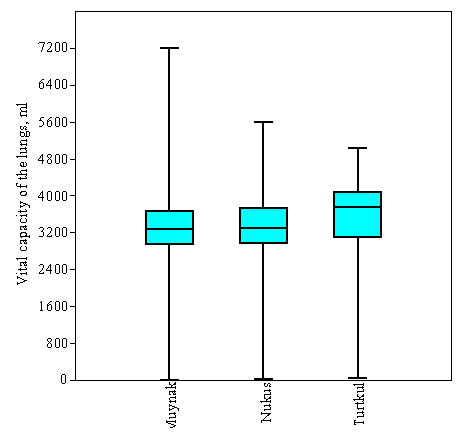 | Figure 3. Comparison of VLC among boys living in different ecological regions (n=983) |
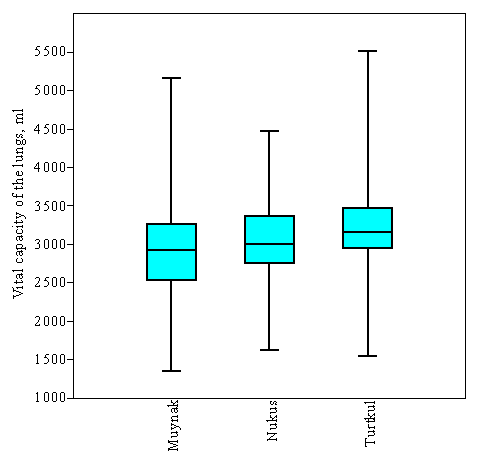 | Figure 4. Comparison of VLC among girls living in different ecological regions (n=872) |
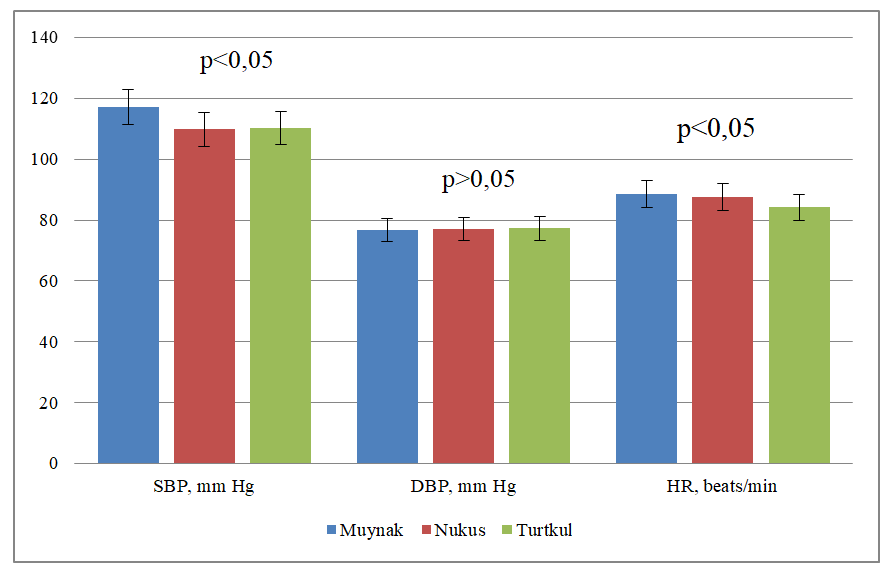 | Figure 5. Comparison of hemodynamic parameters in girls living in the studied regions (n=872) |
4. Conclusions
- Overall, our research findings are consistent with observations conducted in other regions, including the Aral Sea area, industrial zones, and environmentally unfavorable territories. The distinguishing feature, however, is that within Karakalpakstan, the ecological gradient is much more pronounced, with particularly sharp differences observed in adolescents from the Muynak district in terms of respiratory and hemodynamic parameters as well as HGS. These results demonstrate that the impact of ecological factors on the health of the growing generation has specific regional characteristics, which may also be associated with adolescents’ lifestyle, physical activity, and nutritional factors.
Conflicts of Interest
- The authors declare no conflict of interest.
Author Contributions
- K.U. Rozumbetov: Writing – original draft, Supervision and Project Administration, Conceptualization, Visualization, Methodology, Investigation, Resources. G.K. Shamuratova: Resources, Data curation. A.T. Esimbetov: Writing – review & editing, Validation, Formal analysis, Data curation.
Funding
- The author(s) reported no funding associated with the work featured in this article.
ACKNOWLEDGEMENTS
- We thank the participants for their participation in this study.
 Abstract
Abstract Reference
Reference Full-Text PDF
Full-Text PDF Full-text HTML
Full-text HTML